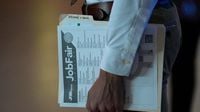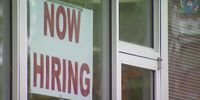July 2025 proved to be a revealing month for the American labor market, with states like Nevada, New Jersey, and Wisconsin each painting a distinct portrait of economic fortunes and anxieties. The latest employment data, released in mid-August, shows a mix of stability, cautious optimism, and persistent challenges, all set against the backdrop of a cooling national economy and political drama at the federal level.
According to the Nevada Department of Employment, Training, and Rehabilitation (DETR), the Silver State’s unemployment rate held steady at 5.4% in July—the highest of any state in the country, and a full 1.2 percentage points above the national average of 4.2% as reported by the U.S. Bureau of Labor Statistics. Only Washington, D.C. reported a higher rate, largely due to federal job cuts. DETR chief economist David Schmidt described the labor market as “relatively steady,” but acknowledged that the private sector has lost jobs in five of the seven months so far in 2025. "While the state added 1,100 jobs over the month, this was concentrated in government employment and is likely related to the larger-than-normal decline in school district employment last month," Schmidt explained, as reported by KSNV.
The numbers tell a sobering story. Nevada’s labor force shrank by 638 jobs in July, and while the state now boasts 1,574,300 nonfarm jobs—a 0.5% increase over the past year—the private sector actually lost 1,200 jobs over the month. Las Vegas, a bellwether for the state’s broader economic health, managed to add 4,200 jobs since June (a 0.4% uptick) and 2,100 since July 2024, but the gains were not enough to offset broader concerns. Reno’s job market was relatively flat, gaining just 100 jobs since June, while Carson City lost 200 jobs over the same period.
Underlying Nevada’s struggles is the state’s deep dependence on tourism and conventions. Casino.org noted that several of Nevada’s largest employers—including MGM Resorts, Caesars Entertainment, Wynn Resorts, Station Casinos/Red Rock Resorts, and Boyd Gaming—have been hit hard by a decline in visitors. Industry observers worry that Las Vegas, once famed for its resilience, may have alienated some former visitors with rising prices, tighter odds, and a proliferation of new fees. "There are growing worries that Las Vegas has turned some former visitors away for good," the report stated, underscoring the uncertainty facing Nevada’s economic engine.
Adding insult to injury, a new study from WalletHub ranked Nevada 45th out of 50 in its “Best States to Live In” for 2025. The state scored poorly in affordability, economy, education and health, and safety, with only its quality of life metric breaking into the top half of the rankings. WalletHub’s researchers weighed 51 different metrics, from homeownership rates to crime statistics, to compile their list, and Nevada’s overall score trailed the national average by a significant margin. While last year Zillow named Pahrump the most popular retirement city for 2024, this latest ranking suggests that many challenges remain for those calling Nevada home.
New Jersey, meanwhile, presented its own complicated picture. Preliminary estimates from the U.S. Bureau of Labor Statistics, released August 14 by the state Department of Labor and Workforce Development, showed the Garden State added 7,500 jobs in July. The private sector was the clear winner, accounting for more than 13,000 new jobs, with the public sector losing 5,600 positions—likely due to limited or delayed hiring of replacements for teachers who left at the end of the school year.
Despite these job gains, New Jersey’s unemployment rate held at 4.9%, still above the national average. Former state chief economist Charles Steindel, writing for the Garden State Initiative, described the results as “mixed.” He noted, "For a second straight month, both the labor force and employment declined—certainly not encouraging," but added, "The job count numbers look much better. There was an overall increase of 7,500, which is the best since February." Steindel pointed to gains in professional and business services and leisure and hospitality, but flagged a notable loss of 1,600 jobs in construction.
Steindel also cautioned readers about the volatility of these figures, especially after a major downward revision to June’s numbers. "It’s useful to keep in mind that these figures are estimates, based on samples. Initial estimates are revised as more of the sample is collected, as well as the receipt of other information," he explained. The August jobs report for New Jersey is due September 18, and many will be watching closely for signs of a more definitive trend.
Wisconsin’s July report, released by the Department of Workforce Development, struck a more subdued note. The state’s labor market “cooled a bit along with the national economy,” according to Scott Hodek, section chief in the office of economic advisors. Wisconsin’s unemployment rate for July was 3.1%—historically low, but employment and labor force participation both edged down. The number of Wisconsinites working dropped by 4,500 from June and by 32,500 from July 2024, while the labor force participation rate slipped to 65%, still ahead of the national average.
Private sector jobs in Wisconsin fell by 3,800 in July, though they remain 15,100 ahead of last year. Construction and manufacturing each shed 500 jobs from June, with manufacturing down 1,800 from a year ago. Hodek pointed to broader national uncertainty and the demographic reality of an aging workforce as key factors, telling the Wisconsin Examiner, "We’re actually still seeing historically low unemployment rates. So you’ve got kind of a mix of up and down indicators."
Nationally, the employment picture was clouded by controversy. The Bureau of Labor Statistics reported the U.S. gained 73,000 jobs in July, well below analysts’ estimates. Previous months’ figures were sharply revised downward, prompting President Donald Trump to fire the BLS’s chief statistician on August 1, 2025, claiming without evidence that the numbers were “RIGGED.” The president replaced her with an economist from the Heritage Foundation, signaling a possible shift in how federal labor data is collected and reported. Hodek, for his part, said, "We do have confidence in our data and we can’t really speculate on what could possibly happen. We’ll just need to wait and see what the Bureau of Labor Statistics actually does down the road."
As summer draws to a close, the state-level jobs reports for July 2025 make one thing clear: while the national economy is cooling, the story on the ground varies widely. Some states are treading water, others are struggling with persistent unemployment, and all are watching Washington for signals of what might come next.






